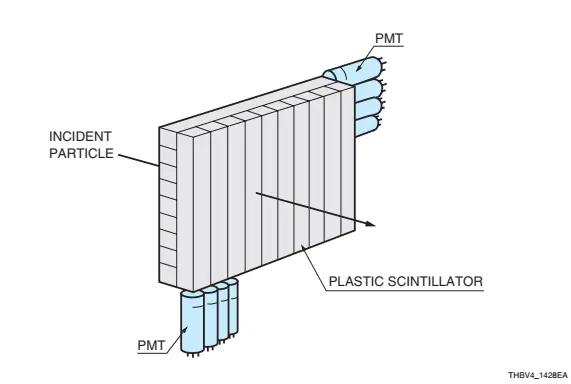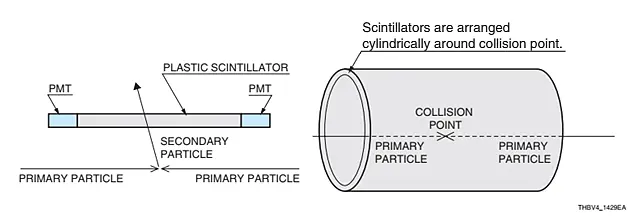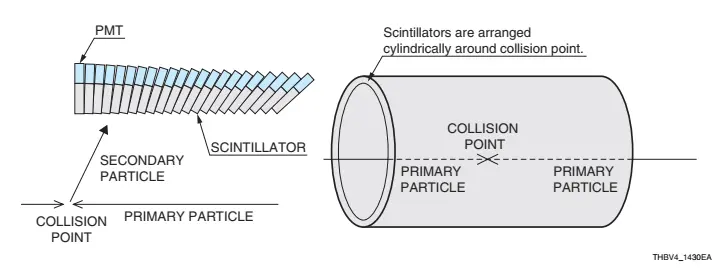Research in high-energy physics aims at new scientific discoveries. In particle collision experiments, primary particles, such as electrons and protons, are accelerated to high energy by an accelerator so that they will collide with each other, creating secondary particles. The energy, velocity and kinetic momentum of these particles are observed and measured. When a charged particle passes through a scintillator, a light pulse is emitted corresponding to the particle energy. Detection of this light pulse by means of a photomultiplier tube makes it possible to measure energy, velocity and direction of a charged particle.
There are several particle detection techniques that use PMTs, which include hodoscopes, time-of-flight counters, calorimeters, and Cherenkov counters.

A hodoscope is a detector system (typically scintillation detectors) which is intended for determination of particle trajectory. Plastic scintillators are assembled in two orthogonal layers followed by photomultiplier tubes. The position and time at which a charged particle passes through certain scintillators are detected by the corresponding photomultiplier tubes.
A time-of-flight counter measures the particle time of flight to identify the particle type. When primary particles collide, secondary electrons are generated. Time of flight of these secondary particles from the collision point to the time-of-flight counter is measured to find out the velocity of the particles. A typical detector consists of a long plastic scintillator, both ends of which are connected to a photomultiplier tube. A large number of plastic scintillators are arranged cylindrically around the collision point.

Calorimeters measure energy of such secondary particles as electrons, photons and hadrons. The collision point is surrounded by detectors. In case of calorimeters particle energy is released into the material and is converted into light or electric charge. These are usually measured with detectors consisting of an inorganic scintillator or lead glass combined with a photomultiplier tube.

Cherenkov light is emitted when a charged particle with velocity or energy above a certain level passes through the emitter material, which is a transparent medium. This Cherenkov light is a kind of impact wave, which is emitted in the shape of a cone around the charged particle direction, forming a ring structure. The energy and type of the particle can be determined based on the size and brightness of this ring. Cherenkov light is converted into electric signal using photomultiplier tubes.

The figure shows a schematic example of a Cherenkov counter called RICH (Ring Imaging Cherenkov Detector).In this example aerogel is used as the radiator. When π-mesons or K-mesons pass through the radiator, the Cherenkov light is emitted in a cone-shaped way. This light is detected by photodetector arrays, and particle type is identified based on ring imaging data.
Since Cherenkov light time is 10-11 -10-12 sec, the temporal resolution of Cherenkov detectors is limited only by PMT and recording electronics performance. Conventional dynode PMTs have a temporal resolution of 5-10 ns, which significantly limits the resolution of the detectors compared to MCP-PMTs, which have a temporal resolution of 1 ns.
The figure shows a schematic example of a Cherenkov counter called RICH (Ring Imaging Cherenkov Detector).In this example aerogel is used as the radiator. When π-mesons or K-mesons pass through the radiator, the Cherenkov light is emitted in a cone-shaped way. This light is detected by photodetector arrays, and particle type is identified based on ring imaging data.
Since Cherenkov light time is 10-11 -10-12 sec, the temporal resolution of Cherenkov detectors is limited only by PMT and recording electronics performance. Conventional dynode PMTs have a temporal resolution of 5-10 ns, which significantly limits the resolution of the detectors compared to MCP-PMTs, which have a temporal resolution of 1 ns.
Sapphire-2AM and Topaz-M MCP-PMTs from VTC Baspik are successfully used as Cherenkov detectors.